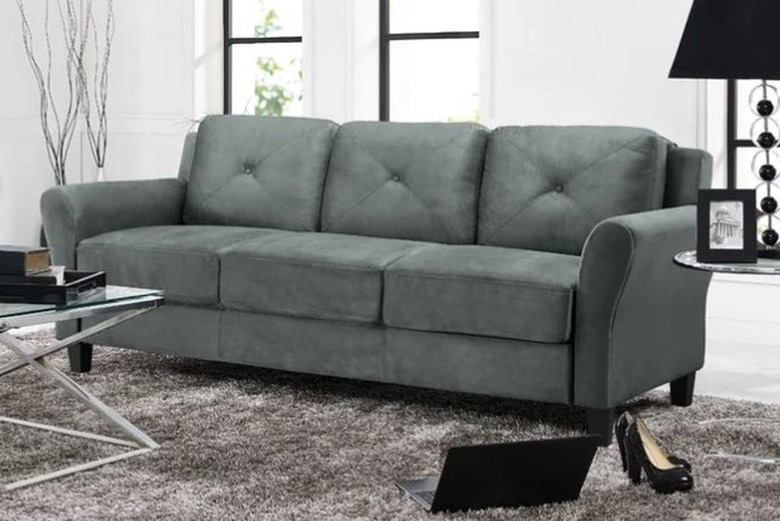Difference Between Microfiber And Microsuede Furniture
Buying new furniture can be an expensive proposition, and it can also be confusing. When sales staff begin throwing out references to "microsuede" and "microfiber," the difference isn't apparent, and it can sound like one big word salad. All you know is that you want attractive, comfortable, long-lasting pieces — not vocabulary lessons. In reality, though, it's a pretty good idea to get a handle on the terminology so you'll know exactly what you're paying the bucks for — and besides, the difference between microsuede and microfiber furniture is easy to understand.
Microfiber: An Umbrella Term
Microfiber: An Umbrella Term
"Microfiber" is actually an umbrella term describing many types of synthetic fabrics usually made from polyester, nylon, or a combination of the two. The tiny fibers are even thinner than silk fibers, a quality allowing production of luxurious-feeling copies of fabrics like leather and silk.
Furniture upholstered in microfiber fabric is durable, comfortable, resistant to staining, and fairly easily cleaned. Dust doesn't settle in microfibers but is trapped by them, which means that vacuuming is particularly effective. Lint, pet hair, and human hair are also easily attracted by the fabric, but they can be easily removed.
Microsuede: A Type of Microfiber
Microsuede: A Type of Microfiber
The distinction between "microsuede" and "microfiber" is easy to grasp. Microsuede is simply one of the many types of fabrics made from microfiber — one that looks and feels not exactly like but very similar to real suede, with many more advantages over the real thing when used to upholster furniture.
Microsuede is less expensive than actual suede. It's softer yet more durable, and it's much more stain-resistant than the real thing. One of its greatest features as an upholstery fabric is that unlike real suede, it's normally available in a vast selection of colors, which is great for home decor color-choice purposes.
Caring for Microsuede
Caring for Microsuede
If you're going to own microsuede furniture, you'll need to know how to clean it and most important, how not to clean it.
Microsuede resists water and spills, but generally, if you rub things into the fabric, it will stain, even with water. So, the first rule is never to rub microsuede. Most things spilled on it will sit on the surface, so you simply need to blot and dab, and you need to do it as soon as possible so the stain isn't forgotten or accidentally rubbed in by someone who sits on it. Second, don't use soap on microsuede. It will stain the fabric.
To accurately determine the best way to clean your microsuede furniture when it's too late to dab, consult the tag attached to the furniture to learn which type of microsuede you have. A label showing an "X" means no liquid cleaners are allowed — only vacuuming. A "W" label requires a water-based cleaning solution. For furniture labeled "S-W" or "W-S," you can use either water or a solvent-based cleaner. Microsuede furniture with an "S" label will show water stains and requires special solvent.
